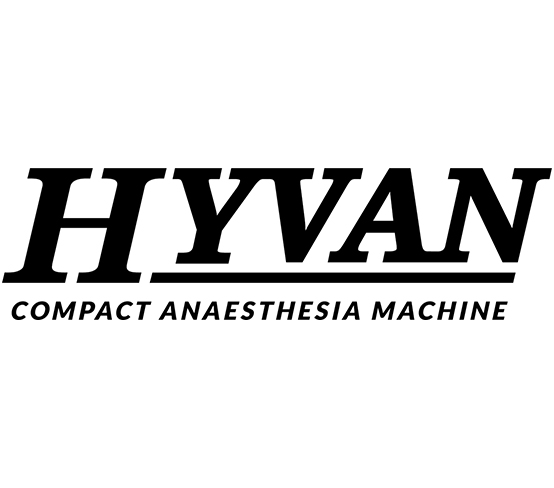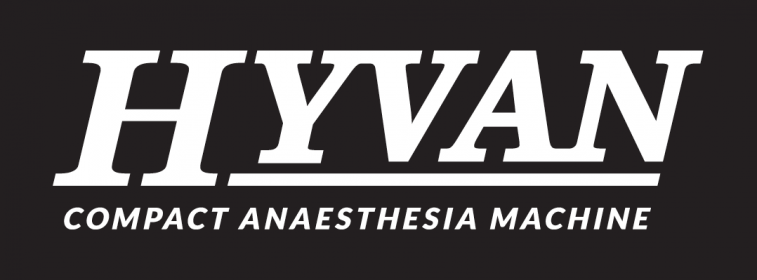FAQs
FREQUENTLY ASKED QUESTIONS (FAQ'S)
1. What does the name HYVAN mean?
The name HYVAN is derived from John HYndman and IVAN Batistich. In the Finnish language HYVAN means good.
2. Does the HYVAN use nitrous oxide?
No. In many developing countries nitrous oxide is unavailable or very expensive. I (John Hyndman) rarely use nitrous oxide in my practice. There is always the risk of delivering an hypoxic mixture. Nitrous Oxide could be added to the HYVAN but the safety features required would make the HYVAN significantly more expensive.
3. Does the HYVAN have an APL (adjustable pressure limiting) valve?
The HYVAN has an automatic APL valve. It is incorporated within the ventilator bellows block and operates automatically whether the paieint is on the ventilator, manually ventilated or spontaneously breathing. This is a significant safety feature as it eliminates the risk of the patient's lungs being over inflated. (a problem with conventional anaesthetic machines).
Example: The patient is induced and allowed to breathe spontaneously on a face mask. There is no "breathing bag". Instead the patient's breathing can be observed by watching the ventilator bellows move up and down. It is similar to placing a patient on a spirometer. The oxygen flow meter is adding gas to the circle so this needs to be vented to prevent the pressure in the circle rising. Normally this would be done by adjusting the APL valve. With the HYVAN this occurs automatically by utilizing the ventilator spill valve.
The patient can continue breathing spontaneously and we can watch the bellows moving accordingly. If the patient is then paralysed and intubated, it is simply a matter of turning the ventilator on (no switching required) to ventilate the patient. The appropriate respiratory rate and I:E ratio are selected and the tidal volume is set by adjusting the tidal volume knob.
When the operation is over, the ventilator is switched off and the patient allowed to breathe. If necessary, respiration can be assisted by occasional compressions of the self inflating bag (this bag is similar to an AMBU bag and the anaesthetist mimics the action of the ventilator by using the self inflating bag to pressurise the "bag in bottle").
Should the anaesthetist wish to add CPAP (eg post extubation laryngospasm), the expiratory limb of the patient breathing circuit can be removed from the red connector on the HYVAN and the "CPAP valve" inserted into the end of the expiratory limb. This is set to pressure limit at 30 cm water. This provides the necessary CPAP (referenced by checking the patioent manometer). It is commom practice to apply 15- 30 cm of water for severe laryngospasm. This can be controlled by bleeding the oxygen from the face mask.
4. What happens if the electricity fails?
The HYVAN has a 'bag-in-bottle' bellows ventilator. Should the supply of compressed gas fail,the anaesthetist can take over and manually bag the patient with the self inflating bag (SIB). In effect the hand bagging mimics the action of the compressed gas that usually drives the ventilator by pressurising the bottle and compressing the bellows. All that is required is a minimum oxygen flow via the flowmeter of 1 - 2 litres/minute.
The patient can also breathe spontaneously (again with a minimum oxygen flow of 1 - 2 litres/minute.)
The HYVAN with its self inflating bag has a huge advantage over most other anaesthetic machines should the electricity fail. Our suggestion is to have a small oxygen cylinder filled with oxygen from the oxygen concentrator and kept for emergencies. A small cylinder of oxygen will contain more than 600 litres of compressed oxygen - enough to keep the HYVAN running for several hours at 1 - 2 litres / minute.
All the alarms continue as usual - ( the battery will maintain the electronics for approximately 100 hours). The HYVAN 9A monitor will continue on its internal battery for up to 4 hours.
Of course most hospitals will have a petrol or diesel generator should the electricity fail but the message is that the HYVAN can be used in the event of a power failure - providing a minimum flow of oxygen at 1 - 2 litres / minute can be provided.
5. Can the HYVAN be used for paediatric patients?
Yes. The HYVAN can be used in all age groups. In fact the HYVAN is particularly suited to ventilating small children due to the pressure control function.
The ventiator can be set up to deliver 50 ml tidal volume at a maximum pressure of 12 cm water. The absence of an APL valve removes the risk of accidently hyper-inflating the child's lungs.
An Ayres - T - piece can be attached to the green outlet of the HYVAN
6. Can any vaporizer be used?
Yes - any plenum vaporizer that will fit onto a selectatec back bar. The vaporizer sits on the deck of the HYVAN and the selectatec fitting is adjustable to fit depending on the height of the vaporizer.
7. Can the HYVAN be serviced and maintained in a small hospital workshops?
Yes - the HYVAN has been designed for easy maintenance and this can be carried out by the hospital technician. A comprehensive instruction book is provided.
8. Can the HYVAN use refillable and disposable soda lime canisters?
The HYVAN can accommodate a variety refillable and disposable canisters. The 'shoe' fits the Anmedic 'Q' system and the ADU.
We provide a Royal reusable canister. Suitable disposable canisters include the Intersurgical IS Pac (500 g), the Armstrog Q Can (AMAB3802 (800 g) and the GE Aisys canister.
9. Is a monitor available?
The HYVAN can be used without a monitor. However monitors are now affordable and extremely reliable. We recommend using a montitor that measures ECG, SpO2, and blood pressure. It is also important to be able to measure end tidal CO2, oxygen and volatile agent concentrations.
We can supply a HYVAN monitor (Hyvan 9A or 5A) that measures all these parameters (supplied with a gas bench - either sidestream or mainstream). For further information regarding MONITORS, VAPORISERS and HYVAN TRANSPORT BOX see the RESOURCES section.
10. Is there an oxygen concentrator available to drive the Hyvan Alice?
The output from most oxygen concentrators is approximately 10 litres/minute of 95% oxygen. However the pressure (around 10 psi) is too low to drive a pneumatic ventilator. We have custom made an oxygen concentrator with a powerful compressor and an air resevoir tank. This allows us to get two outputs - and oxygen flow (10 lpm, 95% and 10 psi) AND a compressed air supply (40 - 50 psi). This combination enables the Hyvan Alice to have an oxygen supply and a ventilator drive from the compressed air. This has been trialed and we are delighted with it. Of course an electricity failure would mean interruption of the compressed air but it is a simple matter to continue hand bagging the patient. There should always be a reserve tank of oxygen to allow a flow of 1 lpm for such occassions.
For further information on the HYVAN AIR/OXYGEN COMPRESSOR CONCENTRATOR SEE THE RESOURCES SECTION.
11. Is Hyvan Anaesthesia Limited ISO 13485 certified?
Yes.

